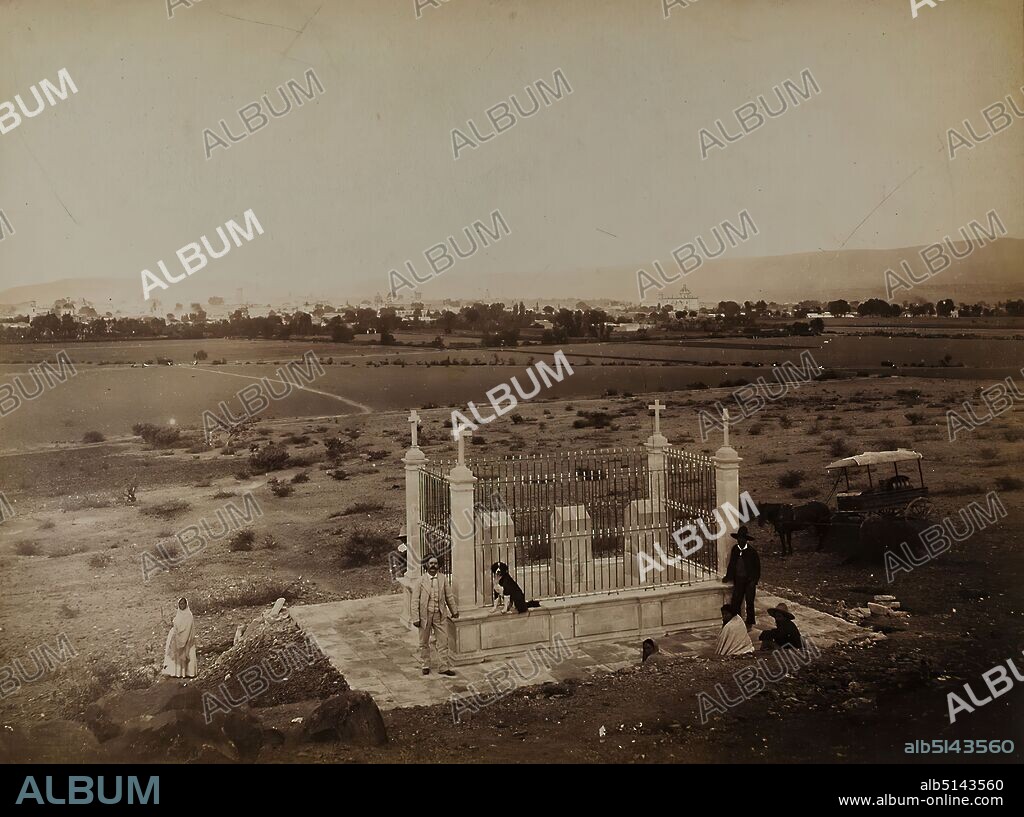alb5143560
William Henry Jackson, Querétaro, Mexico. Monument to Maximilian von Habsburg, albumin paper, black and white positive process, image size: height: 25 cm; width: 33.6 cm, inscription: verso: in lead: v. Hesse - Wartegg, Geographical Society, in Hamburg, library, travel photography, monument, landscape with plants, city, city view (veduta), group portrait, vehicles covered with animals (carriage etc.), man, woman, dog, horse, standing figure, sitting figure, headgear, hist. Building, location, street, Mexico, With the aim of establishing a monarchy in Mexico dependent on France, the Habsburg Ferdinand Maximilian of Austria (1832-1867) was enthroned as Emperor of Mexico in 1864 at the instigation of Napoleon III. After the withdrawal of the French in 1866, Maximilian could no longer hold on to power. In May 1867, he was captured by the troops of the legitimate government around Benito Juárez in Querétaro and, following a court-martial decision, was shot on June 19, 1867, along with his generals Miguel Miramón and Tomás Mejía. In 1886, a first monument was erected at the place of execution, which the American photographic pioneer William Henry Jackson (1843-1942) captured in pictures during his excursions to Mexico. It consisted of three enclosed stone pillars with the names of the executed. Today, a chapel consecrated in April 1901 commemorates Maximilian at this site.

|
Add to another lightbox |
|
Add to another lightbox |



Buy this image.
Select the use:

Caption:
William Henry Jackson, Querétaro, Mexico. Monument to Maximilian von Habsburg, albumin paper, black and white positive process, image size: height: 25 cm; width: 33.6 cm, inscription: verso: in lead: v. Hesse - Wartegg, Geographical Society, in Hamburg, library, travel photography, monument, landscape with plants, city, city view (veduta), group portrait, vehicles covered with animals (carriage etc.), man, woman, dog, horse, standing figure, sitting figure, headgear, hist. Building, location, street, Mexico, With the aim of establishing a monarchy in Mexico dependent on France, the Habsburg Ferdinand Maximilian of Austria (1832-1867) was enthroned as Emperor of Mexico in 1864 at the instigation of Napoleon III. After the withdrawal of the French in 1866, Maximilian could no longer hold on to power. In May 1867, he was captured by the troops of the legitimate government around Benito Juárez in Querétaro and, following a court-martial decision, was shot on June 19, 1867, along with his generals Miguel Miramón and Tomás Mejía. In 1886, a first monument was erected at the place of execution, which the American photographic pioneer William Henry Jackson (1843-1942) captured in pictures during his excursions to Mexico. It consisted of three enclosed stone pillars with the names of the executed. Today, a chapel consecrated in April 1901 commemorates Maximilian at this site.
Personalities:
Credit:
Album / quintlox
Releases:
Model: No - Property: No
Rights questions?
Rights questions?
Image size:
4320 x 3222 px | 39.8 MB
Print size:
36.6 x 27.3 cm | 14.4 x 10.7 in (300 dpi)
Keywords:
1832-1867 • 1864 • 1866 • 1867 • AIM • ALBUMIN PAPER • AMERICAN PHOTOGRAPHIC PIONEER WILLIAM HENRY JACKSON • ANIMAL • ANIMALS • APRIL 1901 COMMEMORATES MAXIMILIAN • AUSTRIA • AUSTRIAN • BENITO JUAREZ • BLACK PERSON • BLACK RACE • BLACK • BUILDING • BUILDING. • BUILDINGS • CADRE • CAPTURED • CARRIAGE ETC • CHAPEL CONSECRATED • CITIES • CITY VIEW • CITY • CONSISTED • CONSTRUCTION • CONTEMPORARY • COURT-MARTIAL DECISION • DIAGRAM • DOG • EDIFICIO • EDIFICIOS • EMPEROR • ENTHRONED • EQUUS CABALLUS • ERECTED • ESTABLISHING • EXCURSION • EXCURSIONS • EXECUTED • EXECUTION • FEMALES • FIRING • FOLLOWING • FRANCE • FRANCE. • FRENCH • GENERALS MIGUEL MIRAMÓN • GEOGRAPHICAL SOCIETY • GROUP PHOTO • GROUP PICTURE • GROUP PORTRAIT • GROUP PORTRAITS • HABSBURG FERDINAND MAXIMILIAN • HEADGEAR • HESSE • HIST • HORSE'S • HORSE • HORSES • IMAGES • IN HAMBURG • IN LEAD • IN PAINTINGS • INSCRIPTION • INSTIGATION • INTERIORS: IN PAINTINGS • JUNE 19 • KAISER • LA FRANCE • LANDSCAPE • LANDSCAPES • LEGITIMATE GOVERNMENT • LIBRARIES • LIBRARY • LOCATION • MAN • MAXIMILIAN VON HABSBURG • MAXIMILIAN • MEN • MEXICO DEPENDENT • MEXICO • MONARCHY • MONUMENT • MUJER • NAMES • NAPOLEON III • NEGRA • NO LONGER HOLD • PAINTING (ACTIVITY) • PAINTING • PAINTINGS • PICTURE • PICTURES • PLACE • PLANT • PLANTA • PLANTAE • PLANTS • POWER • QUERÉTARO AND • QUERETARO • ROAD • ROADS • RUA • SHOOTING • SHOT • SIEGE • SITE • SITTING FIGURE • SOLDIER • STANDING FIGURE • STREET • STREETS • THREE ENCLOSED STONE PILLARS • TODAY • TOMÁS MEJÍA • TORMENTER • TOWN • TOWNS • TRAVEL PHOTOGRAPH • TRAVEL PHOTOGRAPHY • TROOPS • V • V. • VEDUTA • VEHICLES COVERED • VERSO • VIA • WARTEGG • WAY • WHITE POSITIVE PROCESS • WILLIAM HENRY JACKSON • WITHDRAWAL • WOMAN'S • WOMAN • WOMAN. • WOMANS • WOMEN'S • WOMEN • WOMENS
 Pinterest
Pinterest Twitter
Twitter Facebook
Facebook Copy link
Copy link Email
Email
